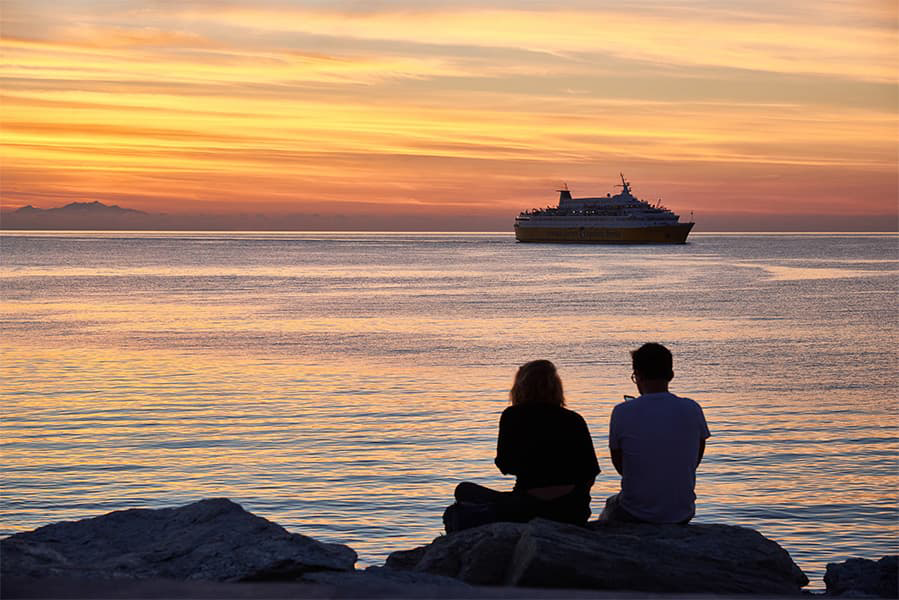Ferries from
Germany to Lithuania
Ferries from
Germany to Lithuania


There are 3 ferry routes. Ferries from Kiel to Klaipeda and Travemunde to Klaipeda are popular ferry trips from Germany to Lithuania. Sailing frequency can change throughout the year and often sailings increase during peak season.
Ferries from Germany to Lithuania sail approximately 7 times per week and are available with TT-Line.
The ferry from Germany to Lithuania takes between 17 hours and 57 hours 35 minutes depending on the ferry route, operator, and ship that you choose.
The fastest ferry from Germany to Lithuania is on the Kiel to Klaipeda ferry with in 17 hours.
Yes, there are car ferries available from Germany to Lithuania with TT-Line.
There are approximately 766 miles (1232km) and 665 nautical miles between Germany and Lithuania.
The price of a ferry from Germany to Lithuania can differ by route, operator, season, vehicle type and whether you are sailing on a high-speed ferry or conventional ferry.
The Kiel to Klaipeda ferry ferry sails approximately 6 times weekly with a crossing time of 20 hours 30 minutes.
Travemunde to Klaipeda ferry ferries sail about 3 times weekly with a sailing time of 31 hours 50 minutes.
We suggest that you book in advance to ensure that you get the cheapest ferry prices and availability. Please check out our special offers page to take advantage of all the latest ferry discounts available.
Book and compare Germany Lithuania ferry tickets, operators, timetables and prices by using our Deal Finder.
More routes than anyone else.

Compare fares, times & routes in one place.
Change plans easily with flexi tickets.

Book e-tickets & manage trips in-app.
Live ship tracking & real-time updates.

Top-rated customer support when you need it.
Germany is a large nation in west-central Europe, known for its spellbinding landscapes, rich history and iconic cuisine. Aside from the stereotypical Bavarian culture of beer, sausage and pretzels found in the south, Germany is a hugely diverse country, offering something for everyone. The capital, Berlin has architectural masterpieces, the famous black forest covers the west, whilst the Alps on the southern border offer great skiing spots. Remnants of the country’s long history can be found almost anywhere, too, whether you’re strolling past the Berlin Wall, touring a World War II museum or marvelling at a medieval hilltop fortress. With a coastline stretching almost 2,500 kilometres, Germany has a wide selection of ports to choose from. There are numerous ferry routes provided to Scandinavia and the Baltic nations, making it an excellent transport hub for northeast Europe.
Lithuania is the southernmost of the Baltic States in Northern Europe, with a short coastline on the Baltic Sea. Gaining independence from Russia after the First World War, Lithuania has since flourished, with an increasing number of tourists unearthing its natural splendour and marvellous cities. Lithuanian landscapes consist primarily of undulating hills, lush forests, glistening lakes and meandering rivers. The coastline, albeit small, is beautiful, and the UNESCO World Heritage-listed Curonian Spit, a thin stretch of silver sand, tops the list of Baltic beaches. The capital is Vilnius, an eastern city characterised by beautiful baroque buildings, cobbled alleyways, endless church steeples and one of the largest Old Towns in Europe. Also, standing elegantly between the Neris and Vilnia rivers, it’s an artist’s dream. Ferries from a couple of European countries sail across the Baltic Sea to the Lithuanian city of Klaipeda. Regular long-haul crossings are available, so be sure to book some comfortable accommodation.